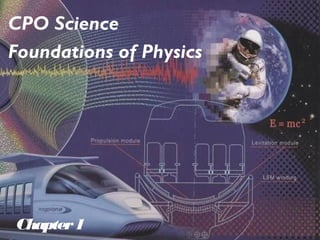
PhysicsChpt1
- 1. Chapter1 CPO Science Foundations of Physics
- 2. Introduction 1.1 The Science of Physics 1.2 The Development of Scientific Knowledge 1.3 Physics is Useful Chapter1: The Science of Physics
- 3. Chapter1 Objectives 1. Describe the process of inquiry and the relationship between inquiry and learning science. 2. Describe the difference between matterand energy. 3. Explain the relationship between a theory, a hypothesis and an experiment. 4. Describe how scientific evidence is used to judge truth. 5. Describe at least three examples of how physics knowledge is used in a careeroroccupation outside of physics.
- 4. Chapter1 Vocabulary Terms natural law process analysis inquiry hypothesis experiment theory energy matter scientific evidence objectivity repeatability *Read Chapter One as an introduction. There is no accompanying investigation.
- 5. 1.1 The Science of Physics Three fundamental aspects of Physics: 1. Describing the organization of the universe. matter and energy 1. Understanding the natural laws that govern the universe. belief that all events follow a set of laws that do not change 1. Deducing and applying natural laws. science as a process
- 6. 1.1 The Science of Physics Matterand Energy *The universe consists of only matter and energy
- 7. 1.1 The Science of Physics Inquiry and Observation *We will explore Physics using inquiry through observation.
- 8. 1.1 Inquiry Three valuable things are learned by discovering the natural laws through inquiry: 1. It includes very practical knowledge. 2. Once you know how something generally works, you can often figure out how to make it work for yo u. 3. You will learn to solve real-life problems.
- 9. Using Problem Solving Techniques Step 1 — Determine what the problem asks you to find out. Step 2 — Identify the information you are given. Step 3 — Identify laws orrelationships. Step 4 — Apply the given information and the relationships.
- 10. Foundations of Physics Units
- 11. 1.2 Development of Scientific Knowledge Models, Evidence, Analysis and Theories
- 12. 1.2 Development of Scientific Knowledge Importance of Experiments We use experiments to test and evaluate theories.
- 13. 1.2 Development of Scientific Knowledge Scientific Evidence Measurements and data Graphs and chartsImages and sketches
- 14. 1.2 Development of Scientific Knowledge Scientific Knowledge and the SolarSystem Early civilizations believed the Earth was covered by a dome on which the sun, stars and planets moved. In the Middle Ages, people thought the sun, stars and planets circled the Earth. Today we know the earth and planets orbit the sun.
- 15. 1.3 Physics is Useful Engineering Medicine and health professions
- 16. 1.3 Physics is Useful Business and finance Art, music, and food
- 17. 1.3 Physics is Useful The relationship between physics and otherfields of science